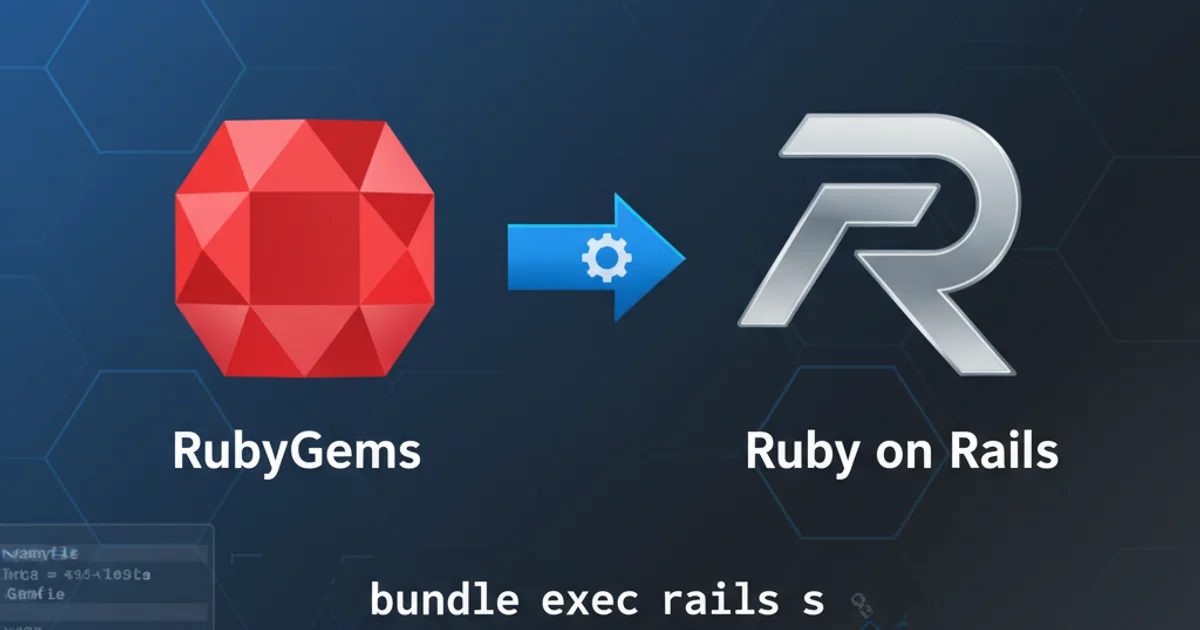What is the difference between "rails s" and "bundle exec rails s"?
Categories:
Understanding 'rails s' vs. 'bundle exec rails s' in Ruby on Rails

Explore the subtle yet critical differences between running your Rails server with rails s and bundle exec rails s, and why one is generally preferred for robust development.
When working with Ruby on Rails applications, you'll frequently encounter two commands to start your development server: rails s and bundle exec rails s. While both appear to achieve the same immediate goal – launching your application – they operate with a fundamental difference related to how RubyGems and Bundler manage your project's dependencies. Understanding this distinction is crucial for maintaining a consistent and stable development environment, especially when collaborating on projects or dealing with multiple Rails applications on the same machine.
The Role of Bundler in Rails Applications
Bundler is Ruby's primary dependency manager. It ensures that your application runs with the exact gems (libraries) it needs, specified in your Gemfile. This prevents version conflicts and ensures that everyone working on the project uses the same set of dependencies. Without Bundler, Ruby applications can become fragile, as different versions of gems installed globally on a system might interfere with each other.
flowchart TD
A[Rails Application] --> B{Gemfile}
B --> C[Bundler]
C --> D[Specific Gem Versions]
D --> E[Consistent Environment]
E --> F[Reliable Application]How Bundler ensures a consistent environment for Rails applications.
What 'rails s' Does
When you execute rails s (short for rails server), you are directly invoking the rails executable that is available in your system's PATH. This executable then attempts to load the necessary gems. If Bundler is installed and configured, rails s will often try to use Bundler to load the gems specified in your Gemfile. However, it relies on the rails executable itself being available and potentially on a globally installed version of Rails or other gems. In some scenarios, especially if your system's global gem environment is not perfectly aligned with your project's Gemfile, this can lead to unexpected gem version mismatches or errors.
rails s
Running the Rails server using the globally available rails executable.
What 'bundle exec rails s' Does
The bundle exec prefix tells Bundler to run the subsequent command (rails s in this case) within the context of the gems specified in your project's Gemfile. Bundler temporarily modifies your RubyGems environment to ensure that only the gems and their versions listed in your Gemfile.lock are available and used. This guarantees that your application runs with the exact dependencies it was designed and tested with, isolating it from any globally installed gems that might conflict. This is the recommended approach for running any command that interacts with your application's dependencies, including tests, migrations, and the server.
bundle exec rails s
Running the Rails server within the Bundler-managed gem environment.
sequenceDiagram
participant User
participant Shell
participant Bundler
participant RailsExecutable
participant RailsApp
User->>Shell: bundle exec rails s
Shell->>Bundler: Execute 'rails s' via Bundler
Bundler->>Bundler: Set up isolated gem environment (Gemfile.lock)
Bundler->>RailsExecutable: Invoke 'rails s' within isolated env
RailsExecutable->>RailsApp: Start Rails server
RailsApp-->>User: Application runningSequence diagram illustrating the execution flow of bundle exec rails s.
bundle exec for commands that interact with your application's dependencies. This includes rails db:migrate, rails console, rake tasks, and any other command that relies on gems defined in your Gemfile.Why 'bundle exec' is Preferred
The primary reason to prefer bundle exec rails s is consistency and isolation. It ensures that your application always uses the exact gem versions specified in your Gemfile.lock, regardless of what other gems might be installed globally on your system. This is vital for:
- Reproducibility: Your application will behave the same way on your machine, a teammate's machine, and a production server.
- Preventing Conflicts: Avoids issues where a globally installed gem version conflicts with a version required by your project.
- Dependency Management: Explicitly uses Bundler's managed environment, making dependency issues easier to diagnose and resolve.
While rails s might work in many cases, especially if your global environment is clean and matches your project's Gemfile, it introduces a potential point of failure. bundle exec removes that ambiguity.
bundle exec, consider using a tool like direnv or a shell alias to automatically prepend bundle exec to commands within your project directory. However, be mindful of the implications of such automation.